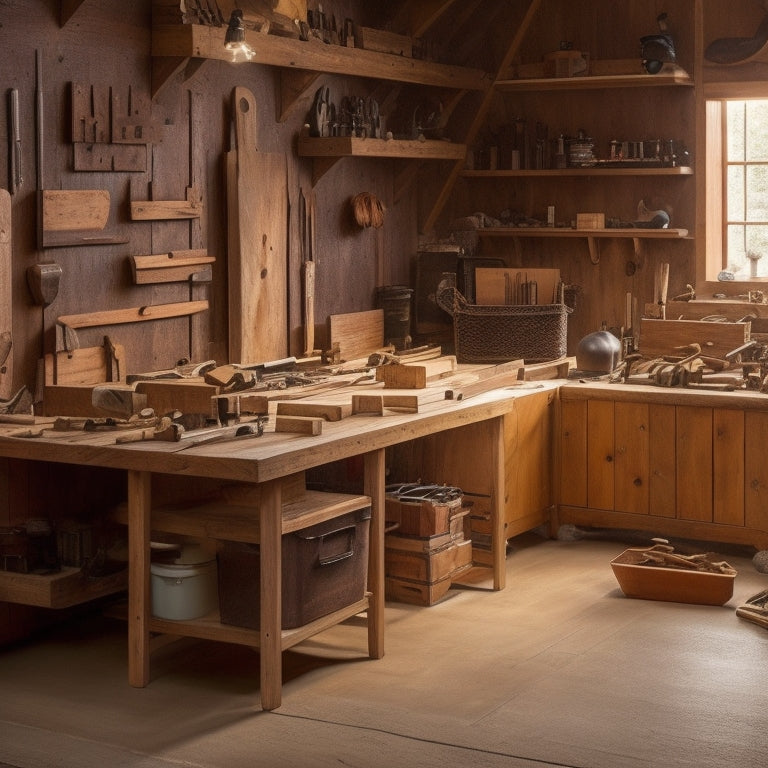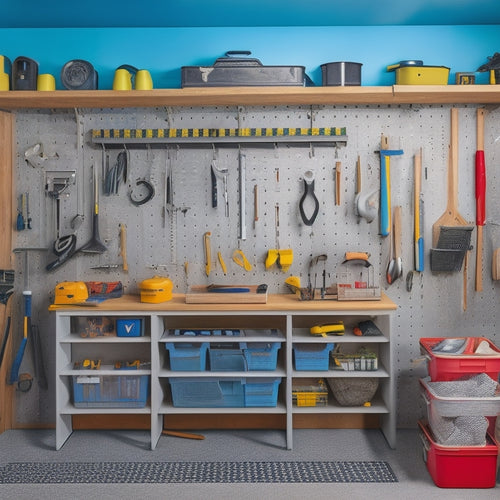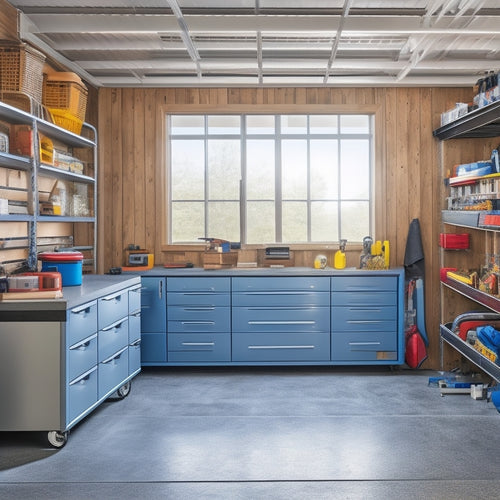
7 Essential Hacks for a Faster Woodshop
Share
You can transform your woodshop into a productivity powerhouse by implementing a few essential hacks. Start by optimizing your workspace layout, positioning frequently used tools and materials within easy reach. Next, streamline your tool organization systems by labeling and categorizing tools, and assigning a specific home for each one. Batch similar tasks together to reduce setup and switching time, and implement efficient material handling strategies like categorizing wood storage and labeling bins. By minimizing distractions, leveraging technology for automation, and prioritizing tasks for maximum output, you'll be well on your way to a faster, more efficient woodshop - and that's just the beginning of your productivity journey.
Key Takeaways
• Optimize your workspace layout to reduce walking distances and increase productivity by positioning frequently used tools and materials within easy reach.
• Implement batch processing techniques by grouping similar tasks together to reduce setup and switching time, maximizing efficiency gains.
• Invest in ergonomic workstation solutions, such as height-adjustable workbenches or sit-stand desks, to reduce fatigue and improve focus.
• Label and categorize tools, and assign a specific home for each, to reduce time spent searching for misplaced items and increase workflow efficiency.
• Use space-saving solutions like wall-mounted shelves and bins to store materials and tools, keeping your workspace clutter-free and organized.
Optimize Your Workspace Layout
By streamlining your workspace layout, you can shave precious minutes off each project, allowing you to tackle more tasks and boost overall productivity. An ergonomic workstation is key to achieving this goal. Consider investing in a height-adjustable workbench or a sit-stand desk to reduce fatigue and discomfort. This will enable you to work efficiently for longer periods.
An efficient layout is essential to saving time and reducing frustration. Start by identifying the tools and materials you use most frequently and positioning them within easy reach. Implement space-saving solutions such as wall-mounted shelves, hooks, and bins to keep your workspace clutter-free. This will help you quickly locate what you need, reducing downtime and increasing your workflow.
Effective workshop organization is also essential to optimizing your workspace layout. Designate specific areas for different tasks, such as a zone for cutting, another for sanding, and so on. This will help you stay focused and avoid wasting time searching for tools or materials.
Streamline Tool Organization Systems
You'll save hours of frustration and wasted time by assigning a designated home to each tool, making sure that everything has its place and is easily accessible when you need it. A well-organized tool storage system is vital for a faster woodshop.
Here are some essential hacks to get you started:
-
Label and categorize: Label each tool and categorize them by type, frequency of use, or project specificity. This helps you quickly identify what you need and where it's stored.
-
Assign a home: Designate a specific spot for each tool, making it easy to find and put back when you're done.
-
Use vertical space: Maximize your wall space by installing pegboards, hooks, or shelves to store tools, keeping them off the floor and out of the way.
-
Store small items: Use small containers or bins to store small items like screws, nails, or drill bits, keeping them organized and prevent loss.
-
Schedule tool maintenance: Regularly clean, oil, and maintain your tools to prevent rust and make sure they're in good working condition when you need them.
Master the Art of Batch Processing
When you master batch processing, you'll be amazed at how much time you can save in your woodshop. By grouping similar tasks together, you'll optimize your workflow and make the most of your time.
Now, let's explore how you can process similar tasks in bulk to maximize efficiency gains and take your productivity to the next level.
Optimize Your Workflow
To maximize your woodshop's productivity, focus on processing similar tasks in batches, allowing you to complete each stage of a project simultaneously. This approach enables you to optimize your workflow, saving time and increasing efficiency.
By grouping similar tasks together, you'll reduce switching costs, minimize setup times, and make the most of your time management skills.
Here are some key strategies to help you optimize your workflow:
-
Prioritize tasks: Identify the most critical tasks that require your attention and tackle them first.
-
Organize your workspace: Make sure your tools and materials are within easy reach to minimize downtime.
-
Use a 'done' list: Track your progress and celebrate your accomplishments to stay motivated.
-
Schedule breaks: Take regular breaks to recharge and avoid burnout.
-
Review and adjust: Regularly evaluate your workflow and make adjustments as necessary to keep it optimized.
Process Similar Tasks
By processing similar tasks in batches, you can streamline your woodshop's operations and make significant gains in efficiency, freeing up time for more important tasks or taking on additional projects. This concept, known as task batching, is a powerful time management technique that can revolutionize the way you work.
When you group similar tasks together, you reduce the time spent on setup, cleanup, and switching between tasks. For instance, if you're working on a project that requires multiple pieces of wood to be cut to the same size, do them all at once. This approach not only saves time but also reduces the likelihood of errors.
Process optimization is key to achieving maximum efficiency in your woodshop. By identifying tasks that can be grouped together, you can create a more efficient workflow.
Start by analyzing your workflow and identifying tasks that share similar characteristics, such as cutting, sanding, or assembling. Then, create batches of tasks that can be completed in a single session.
With task batching, you'll be amazed at how much more you can accomplish in less time.
Maximize Efficiency Gains
Take your batch processing to the next level by identifying the most time-consuming tasks in your woodshop and grouping them into batches that can be completed in a single session, freeing up more time for high-leverage activities. This time management strategy allows you to maximize efficiency gains and boost your productivity.
Here are some productivity hacks to help you master the art of batch processing:
-
Prioritize tasks: Identify the most critical tasks that require your attention and group them into batches based on their complexity and urgency.
-
Set a schedule: Allocate specific time slots for each batch, ensuring you have enough time to complete each task without feeling rushed or overwhelmed.
-
Minimize tool changes: Group tasks that require the same tools or setup to reduce downtime and maximize your workflow.
-
Batch similar tasks: Process similar tasks together, such as cutting multiple pieces of wood to the same size, to reduce mental fatigue and increase accuracy.
-
Take breaks: Take regular breaks between batches to recharge and maintain your focus, ensuring you stay productive throughout the day.
Implement Efficient Material Handling
You'll save time and energy by streamlining your material handling process, which starts with organizing your wood storage and ensuring easy access to the materials you need.
A well-organized material storage system allows you to quickly locate the specific type and quantity of wood required for your project. Consider using bins, baskets, or shelves to categorize and store your materials. Label each storage unit clearly, so you can easily identify what's inside.
Efficient tool transport is also vital in your woodshop. Invest in a tool cart or a mobile workstation that can hold your essential tools and supplies. This will enable you to move quickly and easily around your workspace, reducing the time spent walking back and forth to retrieve tools.
Additionally, consider using a pegboard to hang your frequently used tools, keeping them within easy reach. By optimizing your material storage and tool transport, you'll be able to work more efficiently, reducing downtime and increasing productivity in your woodshop.
Minimize Distractions and Interruptions
To maximize your woodshop's productivity, you need to create an environment that allows you to focus on the task at hand. Distractions and interruptions can quickly add up, eating away at your time and energy.
Eliminate Digital Noise
In today's digitally connected world, your phone, computer, and other devices are constantly vying for your attention, making it essential to establish boundaries and minimize digital distractions in your woodshop.
Digital decluttering is key to noise reduction, and it starts with identifying the sources of digital noise in your workspace.
Here are some simple ways to eliminate digital noise:
-
Turn off notifications on your phone or put it on silent mode while you're working.
-
Close unnecessary tabs on your computer or consider using a website blocker to minimize online distractions.
-
Set specific times to check your email or social media, and stick to those times.
-
Consider implementing a 'no meeting day' or setting specific meeting times to minimize interruptions.
-
Establish a 'no phone zone' in your woodshop to keep you and your team focused on the task at hand.
Set Boundaries Firmly
TEXT
Setting boundaries is crucial for maintaining healthy relationships. It is important to clearly communicate your limits and expectations to others. Boundaries help protect your well-being and ensure that your needs are being met. In order to set boundaries effectively, it is essential to be assertive and respectful. Remember that it is okay to say no and prioritize self-care. By establishing boundaries, you establish a sense of control and create a more positive and balanced dynamic in your relationships.
Communicate Openly and Honestly
Effective communication is key to building strong and meaningful relationships. Be open and honest with your thoughts and feelings, and encourage others to do the same. Listen actively and empathetically to what others have to say, and express yourself in a clear and non-confrontational manner. Avoid making assumptions and seek clarification when needed. By fostering open communication, you can deepen your connections with others and resolve conflicts more effectively.
Practice Empathy and Understanding
Empathy is the ability to understand and share the feelings of others. By practicing empathy, you can develop a deeper appreciation for the experiences and perspectives of those around you. Show compassion and kindness towards others, and try to see things from their point of view. Understanding where others are coming from can help you build stronger relationships based on mutual respect and trust. Remember that empathy is a two-way street, and by showing empathy towards others, you are likely to receive it in return.
Schedule Break Times
By planning regular breaks, you can minimize distractions and interruptions, allowing yourself to focus on the task at hand and maintain a consistent workflow.
Effective time management is key to a faster woodshop, and scheduling breaks is an essential part of that. When you take regular breaks, you'll come back to your project refreshed and rejuvenated, ready to tackle the next task with renewed energy and focus.
Here are some tips to help you schedule breaks effectively:
-
Set a timer to remind you when it's time to take a break
-
Use a break schedule to balance work and rest time
-
Take short breaks every hour to stretch and move around
-
Prioritize your most focused work during peak energy hours
-
Plan breaks around tasks that require intense concentration
Leverage Technology for Automation
You can greatly enhance your woodshop's productivity by integrating automated tools and machines that streamline repetitive tasks, freeing up more time for creativity and high-value tasks. By leveraging technology, you can focus on what matters most - designing and building exceptional woodworking projects.
Consider integrating AI-powered machines that use machine learning algorithms to optimize workflows and reduce waste. These machines can analyze data from previous projects and adjust settings for maximum efficiency. Additionally, IoT devices equipped with smart sensors can monitor and control temperature, humidity, and other environmental factors that affect your woodworking projects.
This real-time data enables you to make informed decisions and adjust your processes accordingly. By automating tasks such as material handling, cutting, and sanding, you can reduce labor costs, minimize errors, and increase output. With the right technology in place, you can take your woodshop to the next level and achieve unparalleled efficiency.
Prioritize Tasks for Maximum Output
Organizing your workflow around high-priority tasks enables you to tackle the most time-consuming or critical projects first, ensuring maximum output and minimizing delays. Effective task prioritization is key to maximizing your woodshop's productivity.
By focusing on the most important tasks, you'll be able to manage your time more efficiently and make the most of your available resources.
Here are some essential tips to help you prioritize tasks for maximum output:
-
Identify urgent tasks that require immediate attention, such as meeting deadlines or addressing equipment malfunctions.
-
Break down large projects into smaller, manageable tasks to avoid feeling overwhelmed and increase progress.
-
Consider the complexity and time requirements of each task, prioritizing those that are most challenging or time-consuming.
-
Group similar tasks together, such as sanding or cutting, to minimize setup and handover times.
-
Leave some buffer time in your schedule for unexpected tasks or setbacks, ensuring you can adapt to changing circumstances.
Frequently Asked Questions
How Do I Prevent Wood Dust From Accumulating on My Workshop Floor?
You prevent wood dust from accumulating on your workshop floor by implementing an effective dust collection system and maintaining a regular floor cleaning schedule, ensuring a safer and more efficient workspace.
Can I Use a Cordless Drill for Heavy-Duty Woodworking Projects?
When tackling heavy-duty woodworking projects, you'll find that a cordless drill can be a reliable power tool, but be aware of its limitations, such as reduced torque and shorter battery life, to guarantee you're not left in the dark mid-project.
What Safety Gear Should I Wear When Operating a Table Saw?
You're steering through a woodworking storm, and safety gear is your lifeline. Wear eye protection like goggles or safety glasses to shield from debris, plus ear protection like earplugs or earmuffs to reduce noise.
How Often Should I Sharpen My Hand Saw Blades for Optimal Performance?
You should sharpen your hand saw blades every 1-3 months, depending on usage, to maintain peak performance and cutting efficiency. Regular blade maintenance guarantees a sharper cut, reducing fatigue and increasing saw performance.
Can I Use Plywood as a Substitute for Solid Wood in Furniture Making?
"When building a house, you wouldn't use playing cards as walls, right? Similarly, while plywood has benefits like cost-effectiveness and stability, its drawbacks like delamination and limited design flexibility make it less ideal for furniture making; consider alternative materials like MDF or oriented strand board instead."
Related Posts
-

Advantages of a Pegboard System in Your Garage
You can instantly alter your garage into a more organized, efficient, and productive space by installing a pegboard s...
-

What Are the Advantages of a Wooden Tool Box
You choose a wooden tool box, you're not only getting a reliable storage solution, but also a long list of benefits t...
-

Top Rolling Tool Box Drawers for Maximum Storage
When it comes to maximizing storage with rolling tool box drawers, you need a solution that combines durability, cust...


